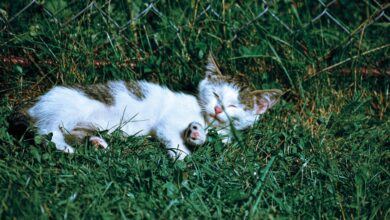Canadian Marble fox is also known as red fox which are wild canines. These creatures have wild nature and even thought they are kept as pets; they are not suited for a living household. Even though they are somewhat dangerous creatures, they are well liked as pets.
It is important to understand here that the Canadian Marble fox is not a specific breed or species of fox found in the wild. Instead, it is the color variation of the red fox which it is found in. Let’s look at variation of these Canadian marble fox kept as pets:
- Russian Domesticated Red Fox: Bred in Russia for research purposes, these foxes have become popular as pets in some countries. They are selectively bred to exhibit more docile and friendly behaviors compared to their wild counterparts.
- Fennec Fox: The Fennec fox is a small desert fox known for its large ears. They are kept as pets in some regions, and their small size and unique appearance make them more manageable for some pet owners.
Russian Domesticated Red Fox
The Russian Domesticated Red Fox, sometimes called as the “Siberian domesticated fox,” was created in a science laboratory through a lengthy scientific experiment that started in the 1950s. Russian geneticist Dmitri Belyaev led this research, which took place for many years at the Institute of Cytology and Genetics in Novosibirsk, Siberia. The goal was to breed foxes to be more friendly and tame. Since it is one of the preferred and well-liked variation of Canadian Marble fox, let explore the characteristics which make it more suitable for keeping as pets.
- Domestication: The project to domesticate the Russian Red Fox was ingrained in the scientific exploration of domestication, a process that had transformed many wild animals into companions of humans throughout history. Researchers aimed to gain insights into this transformation by selectively breeding red foxes based on their behavior.
Specifically, scientists sought to favor foxes that displayed less fear and aggression when interacting with humans. This meant choosing foxes that seem to be more approachable and have a docile demeanor, essentially mimicking some of the traits found in domesticated animals. The idea was to understand the genetic and behavioral changes that occur as wild animals become more compatible with humans. Over many generations, this selective breeding resulted in foxes that were not only less fearful but also more sociable and dog-like in their behavior.
- Tameness: The main idea was to create foxes that were calmer, friendlier, and less scared of people. This process took many generations, but eventually, these foxes began acting more like dogs. They wagged their tails, licked people, and wanted to be around humans. It was a fascinating change in their behavior. This research provided valuable insights into how wild animals can become more like our pets.
- Physical Traits: In addition to their behavior, the appearance of Russian Domesticated Red Foxes also went through alterations. Their fur became more colorful and diverse compared to wild foxes, and it’s not unusual to see them with unique coat patterns. These foxes often have floppy ears, curly tails, and various other physical changes that set them apart from their wild relatives. These transformations are a result of the selective breeding process that aimed to create a domesticated and more visually distinct fox.
- Compatibility: Due to their selectively bred tameness, some Russian Domesticated Red Foxes have been kept as pets in various countries. They are known for their playful and friendly nature, making them intriguing options for individuals interested in exotic pets.
- Care: While they are more harmonious than wild foxes, Russian Domesticated Red Foxes still require special care. Their specific dietary needs, living conditions, and environmental enrichment should be considered.
- Legality of owning them as pets: The ownership of these foxes as pets varies by region and country. Before considering one as a pet, check local laws and regulations to ensure you can legally keep one in your area.
Fennec Fox:
The Fennec Fox, scientifically known as Vulpes zerda, is a captivating and tiny species of fox which is usually found in the arid deserts of North Africa, with a primary habitat in the Sahara Desert. These foxes are famous for several distinctive features and behaviors that have captured the interest and attention of people, making them popular as exotic pets in some regions.
While Fennec Foxes possess charming traits that make them appealing as pets, it’s important to note that they require specialized care and housing. This includes providing a secure enclosure that mimics their desert habitat and ensuring a balanced diet. Additionally, potential owners should be aware of the legal regulations concerning the ownership of Fennec Foxes in their area.
If considering a Fennec Fox as a pet, it’s very important to obtain information from a reputable breeder who prioritizes the animals’ well-being and adheres to ethical breeding practices. Their unique charm and small size have made them popular among those who are prepared to meet their specific care requirements and understand the legal responsibilities associated with owning an exotic pet. Let’s have a look at the distinctive features that stand them out from the other types of foxes:
- Size: Fennec Foxes are among the smallest of all fox species, with an average weight of around 2 to 3 pounds and a body length of about 9 to 16 inches. Their most striking feature is their large ears, which can be over 6 inches long.
- Habitat: As mentioned earlier, Fennec Foxes, are native to the arid deserts of North Africa, particularly the Sahara. They are renowned for their enchanting, petite stature and their disproportionately large, iconic ears, which play a crucial role in heat regulation. As nocturnal creatures, these foxes are most active during the nighttime, adding to their attraction. Their social behavior, observed in the wild where they often live in small groups, has proven them to be affectionate and engaging companions. Fennec Foxes exhibit a resourceful diet that includes insects, small rodents, and plants, with dietary requirements that must be carefully managed in captivity to ensure their well-being.
- Behavior: Fennec Foxes are primarily nocturnal, which means they are most active during the night. They are social animals and can be friendly and affectionate toward their owners. However, they are not necessarily solitary animals in the wild and may live in small groups.
- Diet: In the wild, Fennec Foxes are opportunistic feeders, consuming a variety of foods, including insects, small rodents, plants, and fruits. In captivity, their diet often consists of a balanced commercial diet for exotic pets, supplemented with insects and fruits. If you are looking for more nutritional diet information, visit this website https://www.petfoodinstitute.org/
- Lifespan: In the wild, they typically live for about 6 to 10 years. In captivity, they can live longer, often reaching 12 to 15 years or even more with proper care. Some of the reasons why they live longer in captivity as compared to the wild is due to several crucial factors.
- In captivity, they receive a consistent and well-balanced diet
- Are protected from predators
- Cared for and kept safe from disease and parasite control measures
- Are shielded from extreme environmental conditions.
- Reduced stress levels and early detection and treatment of health issues further contribute to their increased longevity.
However, it’s important to underscore that their well-being in captivity relies on responsible care, a controlled environment that mimics their natural habitat, and adherence to local regulations concerning their ownership, which can vary widely. Acquiring Fennec Foxes from reputable breeders is essential to ensure their proper care and welfare.
- Legality: The ownership of Fennec Foxes as pets varies by location and is subject to specific regulations and permits. Always check local laws before considering one as a pet.
- Care Requirements: Fennec Foxes require specialized care and housing. They need a secure and spacious enclosure, and their diet should be carefully monitored to ensure proper nutrition.
- Socialization: Fennec Foxes can bond with their owners and become affectionate companions, but early socialization is crucial to establish a good relationship. Handling them gently and consistently from a young age is important.
- Vocalization: They are known for their vocalizations, which can include barking, chirping, and other sounds. They can be noisy pets.
To learn more about these fox variations, click on the following link: https://ideaon.info/
As it is mentioned at the start of the article that some of the fox breeds are not suited for keeping as pets. Later on, it is discussed that the Canadian Marble fox is scientifically tamed to turn them into obedient pets. It is essential to understand the reasons why foxes are not considered to be kept as pets at home. While it’s generally not recommended to keep wild animals like Canadian Marble Foxes as pets, and they may not be as trainable as domesticated animals, if you’re interested in training or working with wild animals for conservation or educational purposes, it should be done under the guidance of experienced wildlife professionals and in a controlled environment. Here are some basic training principles and considerations for working with wild animals:
- Positive Reinforcement: Training should be based on positive reinforcement techniques, such as rewarding desired behaviors with treats or other positive stimuli. This helps encourage cooperation and reduces stress for the animal.
- Desensitization: Gradual exposure is a training method that involves introducing wild animals to new experiences, people, and objects in a manner that minimizes fear and stress. This process is conducted slowly and at the animal’s own pace, respecting their natural sensitivities and instincts. The goal is to create positive associations with these novel incentives through positive reinforcement, such as rewards or treats, while closely monitoring the animal’s reactions. Adjustments are made based on the animal’s comfort level, ensuring their safety and well-being throughout the training. It’s a method that recognizes and respects the individuality of wild animals and is often used in environments like wildlife rehabilitation and educational programs to prepare animals for public appearances while prioritizing their comfort and welfare.
- Socialization: Some level of socialization can help wild animals become more accustomed to human presence, but this should be done carefully and with respect for their natural behavior.
- Consistency: Consistency in training methods and cues is a fundamental requirement when working with animals, including wild or exotic species like Canadian Marble Foxes. This means that trainers and handlers must maintain a uniform and predictable approach. Ensure consistency in how they interact with the animal and the signals or commands they use. The significance of this consistency lies in the fact that it provides a clear and reliable framework for the animal to understand what is expected of them. When training cues are consistent, the animal can readily associate specific actions with particular cues, which leads to more effective communication. It reduces confusion and anxiety for the animal, helping them learn and respond to commands more reliably. In the context of training wild animals, such as marble foxes, where unpredictability can lead to stress and undesired behavior, consistency fosters a sense of security and trust in the training process. It also enables handlers to monitor the animal’s progress more effectively and make necessary adjustments as they advance through their training regimen.
- Safety: Ensure the safety of both the animal and the handler at all times. Some wild animals can be unpredictable, so working with professionals and in secure enclosures is vital.Safety: Ensure the safety of both the animal and the handler at all times. Some wild animals can be unpredictable, so working with professionals and in secure enclosures is vital.
- Respect Natural Behavior: Remember that wild animals, even when socialized or trained to some extent, may still exhibit natural behaviors that should be respected.
- Legal and Ethical Considerations: Comply with all local, state, and federal laws regarding the possession and training of wild animals. Be aware of ethical considerations regarding their well-being and conservation.
It’s important to reiterate that the training of wild animals, especially those like Canadian Marble Foxes, should only be undertaken by experienced wildlife professionals in settings like wildlife rehabilitation, conservation, or educational facilities. Attempting to keep wild animals as pets can be detrimental to their well-being and can have serious legal and ethical implications.



